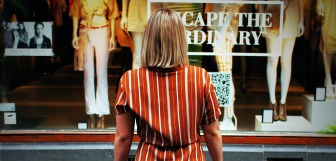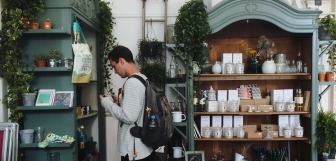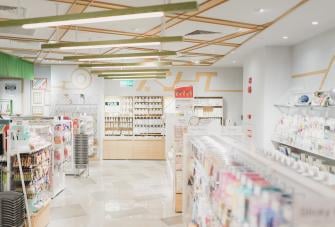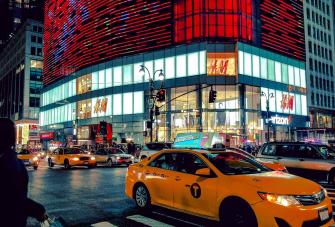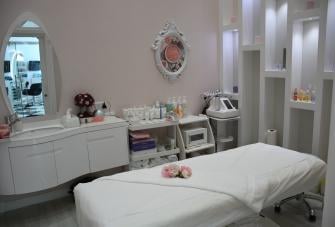Visual Merchandising: Boost Your Sales with These Tips and Tricks in 2023
You may not have entered retail expecting to think too much about aesthetic practices, but every retailer needs to think about visual merchandising. The bottom line in retail is that when customers think your products look good, they spend more!
Consequently, one of the best things a retail store can have going for it is powerful visual displays. But whether your competition is apparel retailers, grocery stores, or niche retailers, you can all be sure the competition will be applying effective visual merchandising as part of their retail strategy just as fiercely as you do.
Even if you feel you lack the creative flair to make your products stand out, the retail industry has some standard practices you can apply to your in-store design and store layout to help increase sales and attract customers.
What does visual merchandising mean?
Visual merchandising encompasses all the ways retailers (and other businesses) strategize displaying products at their best, making them as tempting as possible to customers. This includes store layouts, window displays, interactive installations and special product displays, checkout product displays, and anywhere else you either sell or advertise your products.
While visual merchandising tends to focus on brick-and-mortar stores, and most strategies focus on interior design, the in-store customer experience, and attracting window shoppers to gain new customers, it could also include e-commerce. In the online world, visual merchandising is reliant on effective product imagery and video media, which can be the deciding factor in helping the business make a sale.
In short, creating effective visual merchandising is about adapting your store environment to make shopping a pleasant experience for your customer, grabbing customer attention, encouraging spending, and making your products appealing.
Use Epos Now for the best business aides
An Epos Now retail POS system can help you sell speedily, safely, and securely while providing the latest business tools and integrations for back-office business operations:
- Create your own bespoke system using a variety of software and hardware options.
- Synchronize your system with your preferred business software using the Epos Now AppStore.
- Gain the best business insights to help your visual merchandising through real-time reporting.
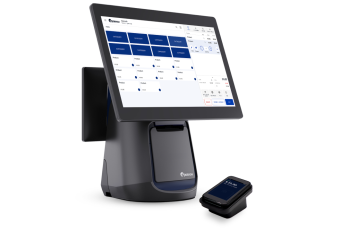
What makes a good visual merchandiser?
If you're looking to improve visual merchandising in your store, there are a number of things you need to focus on to ensure your work is effective. Here are a few qualities you can look for in your staff hires (and develop in yourself) to ensure your store is chock-full of first-class visual merchandisers:
Aesthetic values
It goes without saying that to make your products look good, you need to have a good eye for design. Symmetry, color, good lighting, creating a focal point, drawing the eye to the right places: having a sense of aesthetic isn't just an innate gift. It can also be learned. Studying how to direct the customer's eyes can give you the knowledge you need to use aesthetic values to create the in-store experience you want for customers.
Knowledge of your brand's image
Even the smallest newsagent has a brand. However, the products that any business sells need to be incorporated into that brand. Knowing what qualities your brand image embodies can help you conduct your visual merchandising in a manner consistent with those values.
For instance, a small local shop's brand could be about simplicity, convenience, and value for money. When the customer walks in, they should feel familiar and confident in navigating the store. In this case, to create an effective product display that aligns with the brand, you could highlight great deals. This can prime customers to expect to see low prices on certain products.
On the other hand, in other stores, such as high-end, luxury clothing stores, looking "cheap" will discourage customers from even taking a second glance at a product.
However, in both cases, some customers will make purchases in-store without looking at prices because the visual merchandising gives them confidence that they will be sold at reasonable prices.
While these are two very different examples, knowing the impression the business wants to consistently provide enables a visual merchandiser to create the visual elements of the customer experience in effective ways.
Research, creative thinking, and regular experimentation
Though knowledge of good aesthetic practice and your business's brand can combine to create a visual merchandising process, there is always more a retail business can do to improve those processes.
In order to avoid stagnating and slipping out of customers' minds, paying regular attention to ways you can change and improve your retail space is a crucial practice for good visual merchandising.
This means you need to have the ability to think creatively about what you can do with your space. This may mean engaging with current fashion trends, building seasonal displays, or paying attention to what your target audience enjoys and operating around that.
Visual merchandisers need to be open to studying the evolving practices in retail, be ready to do something novel, and be brave enough to experiment with something they're not sure will work. Even if it doesn't come off quite as you intend, you'll be sure to attract customer attention.
Visual merchandising in 2023: the best tricks
If you're looking for ideas you can use for great visual merchandising in your store, there are many tried and tested strategies that you can expect to work for retailers in 2023. Some may be using the latest technology to create engaging and fresh displays.
Depending on which retail stores are considering them, some of the more stimulating in-store displays may be too much for the target market or for the constraints of the available budget. Nevertheless, what makes visual merchandising important is its ability to cultivate interest in your products. So using the latest methods to the best of your store's ability can help increase sales regardless of your budgetary restrictions.
Theming your displays
Both as a part of your retail branding and for its aesthetic effect, incorporating themes into your interior displays and windows can be an effective way of creating a pleasing atmosphere in store and grabbing attention.
Themes can come in many forms and be used in different ways as part of marketing or just decorating. For instance, it's important that your color scheme works across the store so that the colors can become synonymous with your brand. This leads customers to see a certain shade outside the store and think of you, but also to ensure the store has a consistent look.
But beyond color, you can have themed displays that use words associated with your products and business. If you repeat words and phrases across the store, the customer will think of them when they see the products you want to sell. Repetition used in this way is a powerful part of your visual merchandising, but it needs to be themed to create strong associations with the products.
Repeat slogans
Planning your slogans and written materials out by listing which phrases you want to use on these materials can ensure consistency across the store. The phrases could be as simple as "great value" or "only $x.xx" to imply your prices are better than the competition. But they could also incorporate a unique business slogan, giving customers an idea of who you are.
Repeated slogans can give your store a competitive advantage through a direct connection with the customer. They give you a clear brand identity that customers respond to. Industry trends show recognizable brands are more trustworthy and as many as 81% of consumers want to trust a brand before buying from them[1].
Use people-focused imagery
As with theming, the pictures, graphics, and other forms of in-store advertising should be designed to encourage engagement with the business. Images that help customers see themselves using the products will operate in a suggestive way and boost retail sales.
Your visual merchandising imagery should therefore be positive, contain people using the products you want to sell, and should contain people that reflect your target customer. For instance, if most of your customers are younger women, make sure you include young women in your imagery.
Using positive imagery is a simple, effective way of influencing the atmosphere in your store. Customers behave in ways that reflect the environment they're in. Before and post-purchase, your store should be a pleasant place filled with suggestive visual stimuli that gives your customers a lift. So regardless of what you're selling, putting smiling images in your store can help create the atmosphere you want one that helps you make more sales!
Conduct your own in-store research using your POS
You can read as many retail magazines as you can find, and you'll learn all sorts of visual merchandising tricks, but none of them will be tailored to your own store. However, independent retailers have one sophisticated tool that can be used to gather fantastic customer demographic data that can be used to learn about what works for your business. That tool is a POS (point-of-sale) system.
A POS solution generates reports on product sales, customer behavior, inventory, and transactions as they take place and help you judge your retail performance. Those reports tend to be stored on a cloud and are retained for as long as they are needed. As such, if you make changes to your visual merchandising, you can track the impact those changes have using your POS, helping you to refine the decisions you make and judge their efficacy.
Retailers sell hundreds and thousands of products, making it difficult to evaluate your business decisions. You may think you've pieced together eye-catching product displays, but a POS allows you to break product sales down into specific categories and customer data. You can then see the sales of the products in your display windows and over time in downloadable sheets, graphs, and charts that will confirm their success.
Over time, you'll then know what your customers respond to and can tailor your brand and visual merchandising to your existing customer base for more effective in-store marketing.
-
Offer interactive and digital displays for more customer engagement
Create interactive displays with samples and store products customers can use to see how they feel. These can be particularly effective with children. This kind of in-store attraction can work particularly well for certain kinds of retailers, such as tech stores and games and recreation-based industries. This can also work well for retailers with high enough profit margins that marketing practices such as free samples won't reduce profits excessively.
For the right business, with enough retail space, customers staying on site for longer engaging with media or trying out the products can create a lively, exciting atmosphere that leads to a bigger average spend.
These practices can be effective in creating a lively window display and will often lead to more passing traffic into the store, providing the retail business with more opportunities to capture new customers.
Different areas for the visual merchandiser to focus on
Most visual merchandisers working on improving in-store marketing practices will have several areas in mind when creating a plan. Traditionally, there are design elements in a number of areas of visual merchandising where displaying products can be made to look more appealing to potential buyers.
The window display
A business's window can be the first impression for people discovering your store as they pass. As a result, if you place your best products in your window, shine bright light on them, and use other elements such as effective slogans creating a sense of value, quality, and prestige, you can entice more people into your store.
Applying the principles of visual merchandising to your window displays can be one of the most effective marketing strategies you can employ and does not necessarily require a big budget.
The pre-purchase display
The checkout area offers opportunities for retailers to encourage additional sales with the most tempting impulse products. Few convenience stores fail to profit from sneaky sweets or chocolate bars added to the basket at the last minute each day, and there are innumerable other products, from magazines to chewing gum, that make good additions to the products on the main floor.
To maximize sales on impulse products, we recommend setting different moods at checkout and create special checkout purchase display areas. You can still apply principles around theming, slogan use, lighting, and more, and you can judge the success of your work through your POS reports as with any other part of the business.
In-store display
In-store displays come in many different forms. Some take advantage of a larger area of white space in the center of the floor, while others use the space at the end of aisles. You may also utilize display cases against the walls or use overhead banners depending on the height of your ceiling.
In essence, in-store displays are a great opportunity to make sure every inch of your store is designed in a way to help the business succeed. While thinking about this, it's still important to avoid cluttering your retail store, as visual merchandising only helps customers if they're not overstimulated as they move through the store.
Seasonal displays
Similar to your in-store displays, and possibly as part of them or your window display, taking the opportunity given to you by seasonal holidays. These could include traditional themes of natural seasons or current affairs, and can help inspire a sense of urgency to purchases as well as setting a pleasant mood and making your store an attraction in its own right.
Here are a few holidays that retailers could take advantage of:
- Winter
- Superbowl weekend
- Valentine's Day
- Spring
- Mother's Day
- Easter
- Father's Day
- Independence Day
- Summer/festival season
- Autumn
- Halloween
- Thanksgiving
- Christmas
- New Year's Eve / New Years Day
We hope this article has inspired you with some new ideas for your visual merchandising!
Market your business through the Epos Now Retail System
Managing and running your business is easier with technology that has every tool you need. Epos Now EPOS (electronic point of sale) systems have hardware and software to suit your needs, generating hundreds of reports to help you know more about your business, and feel certain when the price is right.
Epos Now customers can:
- Create bespoke transaction setups on secure, speedy transactions software and an in-house payment processing service to shave time off the sales process.
- Choose from hundreds of apps and integrable partner programs to run accounting, marketing, and other back-of-house functions in a way that suits you.
- Access reports and manage prices and inventory on-site or off, night or day, through cloud technology.
- Purchase all the retail hardware and software and receive expert advice and support around the clock to get the best out of your business.
To find out more about Epos Now solutions, submit your details below and speak to a member of our expert team.
You may also like our articles on:
Join Epos Now for modifiable software and flexible hardware to suit your industry
trusted by over 55,000 businesses worldwide

